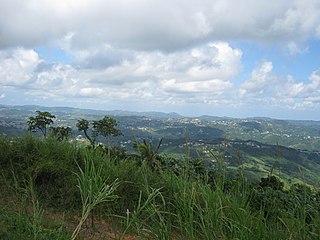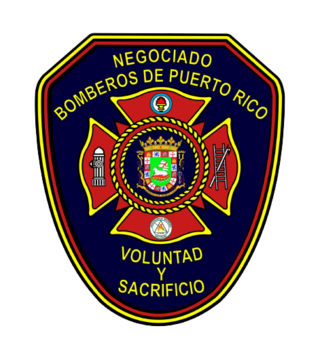
Caguas is a city and municipality of Puerto Rico located in the Central Mountain Range of Puerto Rico, south of San Juan and Trujillo Alto, west of Gurabo and San Lorenzo, and east of Aguas Buenas, Cidra, and Cayey. Caguas was founded in 1775. The municipality had a population of 127,244 at the 2020 census.

Bayamón is a city, municipality of Puerto Rico and suburb of San Juan located in the northern coastal valley, north of Aguas Buenas and Comerío; south of Toa Baja and Cataño; west of Guaynabo; and east of Toa Alta and Naranjito. Bayamón is spread over 11 barrios and Bayamón Pueblo. It is part of the San Juan-Caguas-Guaynabo Metropolitan Statistical Area and the second most populous municipality in both the metropolitan area and Puerto Rico.

Guaynabo is a city, suburb of San Juan and municipality in the northern part of Puerto Rico, located in the northern coast of the island, north of Aguas Buenas, south of Cataño, east of Bayamón, and west of San Juan. Guaynabo is spread over 9 barrios and Guaynabo Pueblo. Guaynabo is considered, along with its neighbors – San Juan and the municipalities of Bayamón, Carolina, Cataño, Trujillo Alto, and Toa Baja – to be part of the San Juan metropolitan area. It is also part of the larger San Juan-Caguas-Guaynabo Metropolitan Statistical Area,.

Aguas Buenas,, popularly known as "La Ciudad de las Aguas Claras" or "The City of Clear Waters", is a town and municipality of Puerto Rico located in the Central Mountain Range, north of Cidra, south of Bayamón, Guaynabo and San Juan; east of Comerio; and north-west of Caguas. Aguas Buenas is spread over 9 barrios and Aguas Buenas Pueblo. It is part of the San Juan-Caguas-Guaynabo Metropolitan Statistical Area.

Cidra is a town and municipality of Puerto Rico located in the central region of the island, north of Cayey; south of Comerío and Aguas Buenas; east of Aibonito and Barranquitas; and west of Caguas. Cidra is spread over 12 barrios and Cidra Pueblo. It is part of the San Juan-Caguas-Guaynabo Metropolitan Statistical Area.

Comerío is a town and municipality of Puerto Rico in the center-eastern region of island, north of Aibonito; south of Naranjito and Bayamón; east of Barranquitas; and west of Cidra and Aguas Buenas. Comerío is spread over 7 barrios and Comerío Pueblo. It is part of the San Juan-Caguas-Guaynabo Metropolitan Statistical Area.

Moca is a town and municipality of Puerto Rico, located in the north-western region of the island, north of Añasco; southeast of Aguadilla; east of Aguada; and west of Isabela and San Sebastián. Moca is spread over 12 barrios and Moca Pueblo. It is part of the Aguadilla-Isabela-San Sebastián Metropolitan Statistical Area.

Sevilla FC Puerto Rico was a Puerto Rican professional association football team based in Juncos, Puerto Rico. Founded in 2006, the team used to play in the Puerto Rico Soccer League. The club was founded in 2006 as a farm team for the Puerto Rico Islanders of the North American Soccer League in Bayamón, but in 2008 partnered with the Spanish La Liga club Sevilla FC and moved a year later to Juncos. Sevilla won both the regular season and play-offs in the inaugural season of the Puerto Rico Soccer League in 2008, and also won the regular season in 2011 before losing the play-off final on penalties to Leones.

The San Juan metropolitan area is a United States Census Bureau defined metropolitan statistical area (MSA) in northeastern Puerto Rico centered around the city of San Juan. A July 1, 2009, Census Bureau estimate placed the population at 2,617,089, a 4.31% increase over the 2000 census figure of 2,509,007.

The Puerto Rico Firefighters Corps (PRFC); is the statewide fire department that provides fire protection, rescue, and protection from other hazards in the U.S. Estado Asociado Libre of Puerto Rico. It was established in 1942 under the Puerto Rico Fire Services. In addition, it offers fire protection services to all the airports under the authority of the Puerto Rico Ports Authority, Rafael Hernández Airport, and Mercedita Airport and they serve as crash rescue divisions. A separate agency, the Puerto Rico Medical Emergency Corps, provides emergency medical services to all Puerto Rico.

The Bayamón River is a river of Puerto Rico beginning at an elevation of approximately 1,476 ft in barrio Beatriz in Cidra, Puerto Rico. It is slightly over 30 miles long and travels through several municipalities: Cidra, Aguas Buenas, Guaynabo, Toa Baja, Bayamón, and Cataño, then empties into San Juan Bay.
The 60th Annual Miss Universe Puerto Rico pageant was held at the Centro Ferial Juan H. Cintrón in Ponce, Puerto Rico, on October 9, 2014. Gabriela Berrios, who won the title of Miss Universe Puerto Rico 2014, crowned her successor at end of the event, Catalina Morales of Guaynabo, who represented Puerto Rico at Miss Universe 2015.
The 2016 Copa Luis Villarejo was the first edition of the Copa Luis Villarejo, a cup tournament for clubs in Puerto Rico organized by the Puerto Rican Football Federation. The champions and runners-up of this tournament are eligible to enter the 2017 Caribbean Club Championship, which serves as a qualifying tournament for the 2017 CONCACAF League and 2018 CONCACAF Champions League.

Bairoa is a barrio or district in the municipality of Caguas, Puerto Rico. Its population in 2010 was 19,258. There are close to 60 sectors in Bairoa.
Starting on December 28, 2019, and progressing into 2020, the southwestern part of the island of Puerto Rico was struck by an earthquake swarm, including 11 that were of magnitude 5 or greater. The largest and most damaging of this sequence was a magnitude 6.4 , which occurred on January 7 at 04:24 AST (08:24 UTC), with a maximum felt intensity of VIII (Severe) on the Modified Mercalli intensity scale. At least one person was killed and several others were injured.
The 2010 Moca earthquake, also referred to as the 2010 Puerto Rico earthquake, occurred on May 16 at 1:16 a.m. local time in Moca, Puerto Rico. The earthquake measured 5.8 on the moment magnitude scale and had a maximum Mercalli intensity of VI (Strong). This was the largest earthquake to strike Puerto Rico since the 1943 Puerto Rico earthquake which measured 7.7 on the Richter scale. This was also the first moderate to major earthquake in recorded history to originate on land in Puerto Rico, as earthquakes in the region usually have their epicenter in the ocean; another earthquake with an epicenter on land would occur later in December of the same year.













